-

人教版高中历史必修2二战后苏联的经济改革教案
⑤强调对外关系的灵活性。戈尔巴乔夫指出在对外政策中要采取多种办法选择不同的策略路线达到既定目标。在外交谈判中不要为自己制造死胡同,也不要给对方制造死胡同,要善于迎合伙伴,寻求接触点。在这种思想指导下,苏共采取的对外战略是以军控为中心的缓和战略,具体政策是继续与美国就裁军、消减核武器、限制地区冲突等问题进行谈判,缓解苏美关系;对西欧争取建立“全欧大厦”;对东欧实行纠偏、不干涉政策;对中国改善关系,实现关系正常化;调整与第三世界国家关系,解决阿富汗、柬埔寨等问题。 3、影响:①经济改革措施仓促上马,缺少宏观决策和相应的配套措施;加上戈尔巴乔夫没有放弃苏联的传统做法,继续优先发展重工业,致使改革未达到预期的效果,苏联经济持续下滑②经济体制改革受挫后,把改革的重点转向政治领域,最终导致国内局势的失控和苏联的解体。
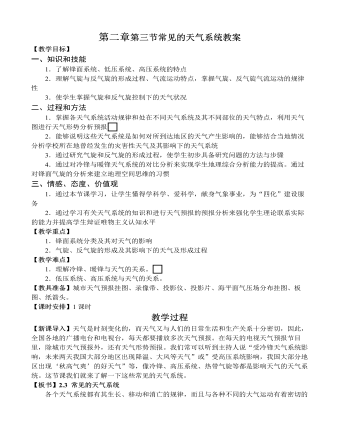
人教版高中地理必修1第二章第三节常见的天气系统教案
一、知识和技能1.了解锋面系统、低压系统、高压系统的特点2.理解气旋与反气旋的形成过程、气流运动特点,掌握气旋、反气旋气流运动的规律性3.使学生掌握气旋和反气旋控制下的天气状况二、过程和方法1.掌握各天气系统活动规律和处在不同天气系统及其不同部位的天气特点,利用天气图进行天气形势分析预报2.能够说明这些天气系统是如何对所到达地区的天气产生影响的,能够结合当地情况分析学校所在地曾经发生的灾害性天气及其影响下的天气系统3.通过研究气旋和反气旋的形成过程,使学生初步具备研究问题的方法与步骤4.通过对冷锋与暖锋天气系统的对比分析来实现学生地理综合分析能力的提高。通过对锋面气旋的分析来建立地理空间思维的习惯三、情感、态度、价值观1.通过本节课学习,让学生懂得学科学、爱科学,献身气象事业,为“四化”建设服务
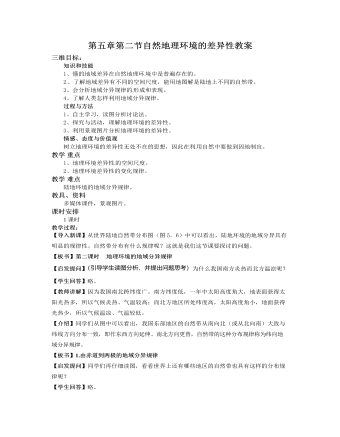
人教版高中地理必修1第五章第二节自然地理环境的差异性教案
【补充说明】我们这节课简要地分析了陆地环境的三种地域分异规律。实际上,世界上的任何事物有其一般性,也有它的特 殊性。在地带性分异规律的基础上,陆地环境因为受到海陆分布、地形 起伏等因素的影响,也会出现一些不规律的现象,这种现象称为非地带性。例如,我们在初中地理中学过绿洲。还记得什么叫绿洲吗?再比如,在南美洲的西海岸(太平洋沿岸),有一条狭长的(热带)荒漠带,而缺少热带草原带,热带雨林带主要是分布在赤道以北地区。这主要是受大的地形起伏的影响。因为南美洲西部是一列高大的安第斯山脉,受其影响,两边的气候状况不同,所以就出现了分布规律不同的自然带,这也是一种非地带性现象。【总结】有规律分布的自然带构成了全球和谐的自然环境整体。自然带之间错综复杂的、微妙的要素关系,有许多是人类还没有认识到的。因此,人类不能随意去破坏任何哪怕是极微小的环节,也许它 带来的影响会是全球性的。保护全球环境,人人有责。
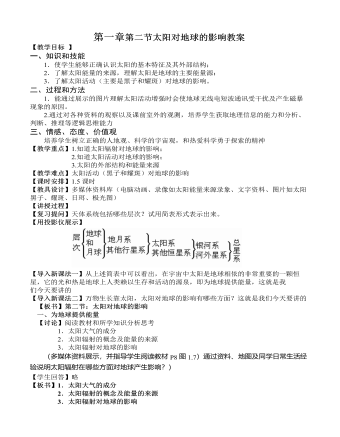
人教版高中地理必修1第一章第二节太阳对地球的影响教案
一、知识和技能1.使学生能够正确认识太阳的基本特征及其外部结构;2.了解太阳能量的来源,理解太阳是地球的主要能量源;3.了解太阳活动(主要是黑子和耀斑)对地球的影响。二、过程和方法1.能通过展示的图片理解太阳活动增强时会使地球无线电短波通讯受干扰及产生磁暴现象的原因。2.通过对各种资料的观察以及课前室外的观测,培养学生获取地理信息的能力和分析、判断、推理等逻辑思维能力三、情感、态度、价值观培养学生树立正确的人地观、科学的宇宙观,和热爱科学勇于探索的精神【教学重点】1.知道太阳辐射对地球的影响; 2.知道太阳活动对地球的影响;3.太阳的外部结构和能量来源【教学难点】太阳活动(黑子和耀斑)对地球的影响
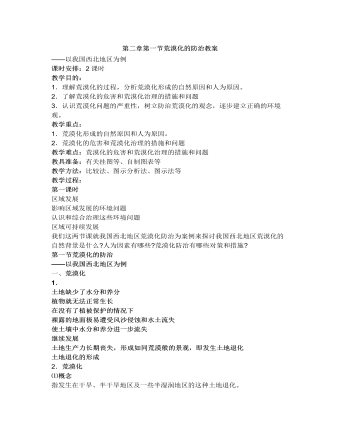
人教版高中地理必修3第二章第一节荒漠化的防治教案
1.根据下面的图文资料,说明前苏联垦荒区土壤风蚀的潜在自然背景。并说明人们的生产活动怎样加剧了这个过程。点拨:对图2.16的分析,要知道”垦荒地区”处于亚欧大 陆的中部偏北的地方,虽处于西风带但远离水汽来源,故降水稀少。从其周边的内陆湖“里海”、“咸海”的分布特点,可以推断,这是一个半荒漠向干草原的过渡地带,是一个生态环境比较脆弱的地区,其自然地理状况必定是寒冷、干旱、大风。2.20世纪60年代中期以来,前苏联在总结大规模垦荒经验教训的基础上,采取了一系列综合防护措施。仔细分析这些措施,你认为该地区防治荒漠化(土壤风蚀)的主要方向是什么?点拨:要善于将所列四项保护措施逐条进行分析,而后进行归纳,不难找出它们之间的共同的东西,那就是“抗旱、防风、保水、保土、保肥”。3.根据所学知识,你认为前苏联垦荒区防治荒漠化的对策与措施可以被我国的哪些地区所借鉴。
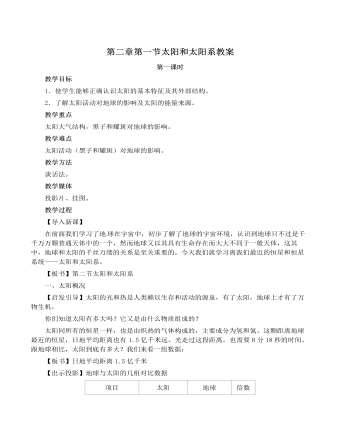
人教版高中地理选修1第二章第一节太阳和太阳系教案
教学过程【导入新课】在太阳系中,九大行星就好像一个家庭中的九个兄弟,有许多共性,今天,我们就一起来了解九大行星在运动特征和结构特征上的共同之处。【板书】3.九大行星的运动特征和结构特征【启发引导】请同学们一起阅读地图册上的“太阳系模式图”,读图分析:(1)九大行星在公转的方向、轨道等方面有什么共性?(2)图中符号“i”、“e”代表什么意思?这两组数字能说明什么问题?九大行星公转的方向相同,均为自西向东转,我们称为同向性。符号“i”表示轨道倾角。(简介黄道、黄道面、轨道倾角)各大 行星的轨道倾角都很小,只有水星和冥王星的大一些,最大也不过17°,说明九大行星的公转轨道近似在同一个平面上,我们称之为共面性。符号“e”代表公转轨道椭圆的偏心率,即焦点到椭圆中心的距离与椭圆半长轴之比,它决定椭圆的形状。偏心率越小,越趋向于圆,当偏心率为0时,轨道就是圆。
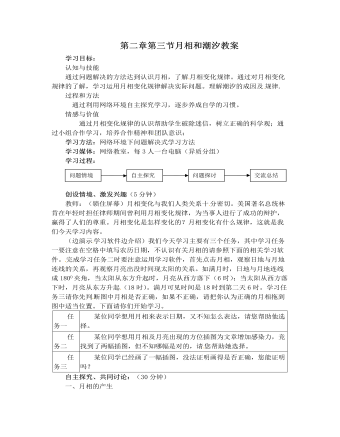
人教版高中地理选修1第二章第三节月相和潮汐教案
创设情境、激发兴趣(5分钟)教师:(锁住屏幕)月相变化与我们人类关系十 分密切。美国著名总统林肯在年轻时担任律师期间曾利用月相变化规律,为当事人进行了成功的辩护,赢得了人们的尊重。月相变化是怎样变化的?月相变化有什么规律,这就是我们今天学习内容。(边演示 学习软件边介绍)我们今天学习主要有三个任务,其中学习任务一要注意在空格中填写农历日期,不认识有关月相的请参照下面的相关学习软件。 完成学习任务二时要注意运用学习软件,首先点击月相,观察日地与月地连线的关系,再观察月亮出没时间现太阳的关系。如满月时,日地与月地连线成1800夹角,当太阳从东方升起时,月亮从西方落下(6时);当太阳从西方落下时,月亮从东方升起 (18时)。满月可见时间是18时到第二天6时。学习任务三请你先判 断图中月相是否正确,如果不正确,请把你认为正确的月相拖到图中适当位置。下面请你们开始学习。
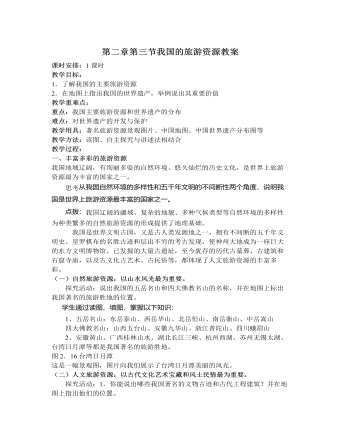
人教版高中地理选修3第二章第三节我国的旅游资源教案
2.对世界遗产的开发与保护原则——保护第一我国的世界文化遗产、世界文化与自然双遗产具有时代性、不可再生性和不可替代性,我国的世界自然遗产都代表着某一类地质地貌中最重要的历史演化过程,展示了我国独特的地质地貌和生物资源。世界遗产的开发与保护之间存在一定的矛盾。我们必须坚持保护第一的原则。旅游开发只是世界遗产的功用之一,必须十分慎重,做到保护与开发协调统一,不能造成对世界遗产的任何破坏。案例②我国第一个世界文化与自然双遗产——泰山通过学习案例②,了解到:①泰山不仅具有科学价值较高的地质构造,还具有多样的地貌景观,罕见的天象景观,丰富的生物资源。泰山自古以来即被誉为名山,受到皇家和百姓的顶礼膜拜,各朝各代几乎都进行过封禅行为,从而留下了深厚的历史文化遗存,这一点跟其他名山相比是独一无二的。
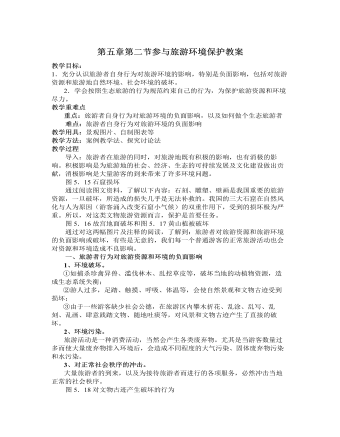
人教版高中地理选修3第五章第二节参与旅游环境保护教案
通过阅读,了解并掌握生态旅游的行为规范,这些行为规范不仅对保护旅游区的资源环境有利,而且为旅游者提供了个人如何更好地获得更大旅游收益的方法和途径。活动“除了脚印什么也不留下,除了照片什么也不带走。人类应该诗意地栖居在大地之上!”这是美国旅行者协会制定的生态旅游者十条道德准则之一,但作为普通游客也应该做到。结合本地实际,组织一次关于生态旅游的专题讨论会,讨论“诗意地栖居”的含义和意义。提示:可按一下步骤进行1.确定讨论会的准备时间(如一周)。2.将学生分成几组。每组确定一个选题,可自定题目,例如:(1)什么是生态旅游?(2)生态旅游为什么有利于保护环境?(3)学校附近有哪些旅游区适合开展生态旅游?(4)如果你去旅游,你会做些什么来保护环境?(5)介绍一个国内外著名的生态旅游区。3.各组分别收集资料,进行组内讨论,并撰写课题报告。4.各小组推选出一名同学向全班同学介绍各自的研究和看法。
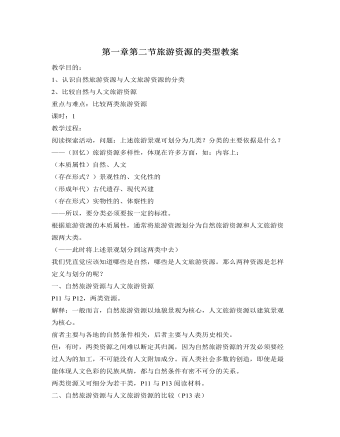
人教版高中地理选修3第一章第二节旅游资源的类型教案
根据旅游资源的本质属性,通常将旅游资源划分为自然旅游资源和人文旅游资源两大类。(——此时将上述景观划分到这两类中去)我们凭直觉应该知道哪些是自然,哪些是人文旅游资源。那么两种资源是怎样定义与划分的呢?一、自然旅游资源与人文旅游资源P11与P12,两类资源。解释:一般而言,自然旅游资源以地貌景观为核心,人文旅游资源以建筑景观为核心。前者主要与各地的自然条件相关,后者主要与人类历史相关。但:有时,两类资源之间难以断定其归属,因为自然旅游资源的开发必须要经过人为的加工,不可能没有人文附加成分。而人类社会多数的创造,即使是最能体现人文色彩的民族风情,都与自然条件有密不可分的关系。两类资源又可细分为若干类,P11与P13阅读材料。
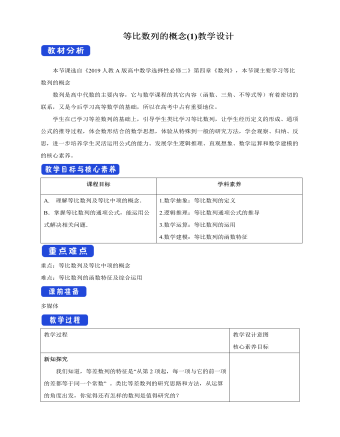
人教版高中数学选择性必修二等比数列的概念 (1) 教学设计
新知探究我们知道,等差数列的特征是“从第2项起,每一项与它的前一项的差都等于同一个常数” 。类比等差数列的研究思路和方法,从运算的角度出发,你觉得还有怎样的数列是值得研究的?1.两河流域发掘的古巴比伦时期的泥版上记录了下面的数列:9,9^2,9^3,…,9^10; ①100,100^2,100^3,…,100^10; ②5,5^2,5^3,…,5^10. ③2.《庄子·天下》中提到:“一尺之锤,日取其半,万世不竭.”如果把“一尺之锤”的长度看成单位“1”,那么从第1天开始,每天得到的“锤”的长度依次是1/2,1/4,1/8,1/16,1/32,… ④3.在营养和生存空间没有限制的情况下,某种细菌每20 min 就通过分裂繁殖一代,那么一个这种细菌从第1次分裂开始,各次分裂产生的后代个数依次是2,4,8,16,32,64,… ⑤4.某人存入银行a元,存期为5年,年利率为 r ,那么按照复利,他5年内每年末得到的本利和分别是a(1+r),a〖(1+r)〗^2,a〖(1+r)〗^3,a〖(1+r)〗^4,a〖(1+r)〗^5 ⑥
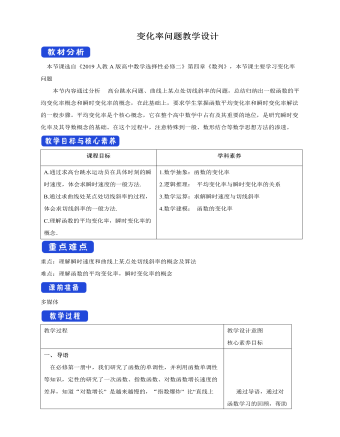
人教版高中数学选择性必修二变化率问题教学设计
导语在必修第一册中,我们研究了函数的单调性,并利用函数单调性等知识,定性的研究了一次函数、指数函数、对数函数增长速度的差异,知道“对数增长” 是越来越慢的,“指数爆炸” 比“直线上升” 快得多,进一步的能否精确定量的刻画变化速度的快慢呢,下面我们就来研究这个问题。新知探究问题1 高台跳水运动员的速度高台跳水运动中,运动员在运动过程中的重心相对于水面的高度h(单位:m)与起跳后的时间t(单位:s)存在函数关系h(t)=-4.9t2+4.8t+11.如何描述用运动员从起跳到入水的过程中运动的快慢程度呢?直觉告诉我们,运动员从起跳到入水的过程中,在上升阶段运动的越来越慢,在下降阶段运动的越来越快,我们可以把整个运动时间段分成许多小段,用运动员在每段时间内的平均速度v ?近似的描述它的运动状态。

人教版高中数学选择性必修二导数的概念及其几何意义教学设计
新知探究前面我们研究了两类变化率问题:一类是物理学中的问题,涉及平均速度和瞬时速度;另一类是几何学中的问题,涉及割线斜率和切线斜率。这两类问题来自不同的学科领域,但在解决问题时,都采用了由“平均变化率”逼近“瞬时变化率”的思想方法;问题的答案也是一样的表示形式。下面我们用上述思想方法研究更一般的问题。探究1: 对于函数y=f(x) ,设自变量x从x_0变化到x_0+ ?x ,相应地,函数值y就从f(x_0)变化到f(〖x+x〗_0) 。这时, x的变化量为?x,y的变化量为?y=f(x_0+?x)-f(x_0)我们把比值?y/?x,即?y/?x=(f(x_0+?x)-f(x_0)" " )/?x叫做函数从x_0到x_0+?x的平均变化率。1.导数的概念如果当Δx→0时,平均变化率ΔyΔx无限趋近于一个确定的值,即ΔyΔx有极限,则称y=f (x)在x=x0处____,并把这个________叫做y=f (x)在x=x0处的导数(也称为__________),记作f ′(x0)或________,即
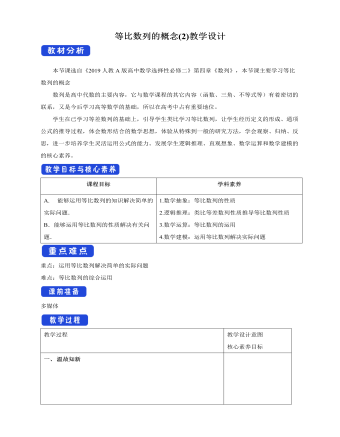
人教版高中数学选择性必修二等比数列的概念 (2) 教学设计
二、典例解析例4. 用 10 000元购买某个理财产品一年.(1)若以月利率0.400%的复利计息,12个月能获得多少利息(精确到1元)?(2)若以季度复利计息,存4个季度,则当每季度利率为多少时,按季结算的利息不少于按月结算的利息(精确到10^(-5))?分析:复利是指把前一期的利息与本金之和算作本金,再计算下一期的利息.所以若原始本金为a元,每期的利率为r ,则从第一期开始,各期的本利和a , a(1+r),a(1+r)^2…构成等比数列.解:(1)设这笔钱存 n 个月以后的本利和组成一个数列{a_n },则{a_n }是等比数列,首项a_1=10^4 (1+0.400%),公比 q=1+0.400%,所以a_12=a_1 q^11 〖=10〗^4 (1+0.400%)^12≈10 490.7.所以,12个月后的利息为10 490.7-10^4≈491(元).解:(2)设季度利率为 r ,这笔钱存 n 个季度以后的本利和组成一个数列{b_n },则{b_n }也是一个等比数列,首项 b_1=10^4 (1+r),公比为1+r,于是 b_4=10^4 (1+r)^4.

人教版高中数学选择性必修二等比数列的前n项和公式 (1) 教学设计
新知探究国际象棋起源于古代印度.相传国王要奖赏国际象棋的发明者,问他想要什么.发明者说:“请在棋盘的第1个格子里放上1颗麦粒,第2个格子里放上2颗麦粒,第3个格子里放上4颗麦粒,依次类推,每个格子里放的麦粒都是前一个格子里放的麦粒数的2倍,直到第64个格子.请给我足够的麦粒以实现上述要求.”国王觉得这个要求不高,就欣然同意了.假定千粒麦粒的质量为40克,据查,2016--2017年度世界年度小麦产量约为7.5亿吨,根据以上数据,判断国王是否能实现他的诺言.问题1:每个格子里放的麦粒数可以构成一个数列,请判断分析这个数列是否是等比数列?并写出这个等比数列的通项公式.是等比数列,首项是1,公比是2,共64项. 通项公式为〖a_n=2〗^(n-1)问题2:请将发明者的要求表述成数学问题.

人教版高中数学选择性必修二等比数列的前n项和公式 (2) 教学设计
二、典例解析例10. 如图,正方形ABCD 的边长为5cm ,取正方形ABCD 各边的中点E,F,G,H, 作第2个正方形 EFGH,然后再取正方形EFGH各边的中点I,J,K,L,作第3个正方形IJKL ,依此方法一直继续下去. (1) 求从正方形ABCD 开始,连续10个正方形的面积之和;(2) 如果这个作图过程可以一直继续下去,那么所有这些正方形的面积之和将趋近于多少?分析:可以利用数列表示各正方形的面积,根据条件可知,这是一个等比数列。解:设正方形的面积为a_1,后续各正方形的面积依次为a_2, a_(3, ) 〖…,a〗_n,…,则a_1=25,由于第k+1个正方形的顶点分别是第k个正方形各边的中点,所以a_(k+1)=〖1/2 a〗_k,因此{a_n},是以25为首项,1/2为公比的等比数列.设{a_n}的前项和为S_n(1)S_10=(25×[1-(1/2)^10 ] )/("1 " -1/2)=50×[1-(1/2)^10 ]=25575/512所以,前10个正方形的面积之和为25575/512cm^2.(2)当无限增大时,无限趋近于所有正方形的面积和
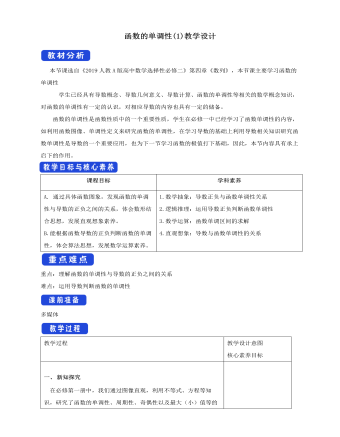
人教版高中数学选择性必修二函数的单调性(1) 教学设计
1.判断正误(正确的打“√”,错误的打“×”)(1)函数f (x)在区间(a,b)上都有f ′(x)<0,则函数f (x)在这个区间上单调递减. ( )(2)函数在某一点的导数越大,函数在该点处的切线越“陡峭”. ( )(3)函数在某个区间上变化越快,函数在这个区间上导数的绝对值越大.( )(4)判断函数单调性时,在区间内的个别点f ′(x)=0,不影响函数在此区间的单调性.( )[解析] (1)√ 函数f (x)在区间(a,b)上都有f ′(x)<0,所以函数f (x)在这个区间上单调递减,故正确.(2)× 切线的“陡峭”程度与|f ′(x)|的大小有关,故错误.(3)√ 函数在某个区间上变化的快慢,和函数导数的绝对值大小一致.(4)√ 若f ′(x)≥0(≤0),则函数f (x)在区间内单调递增(减),故f ′(x)=0不影响函数单调性.[答案] (1)√ (2)× (3)√ (4)√例1. 利用导数判断下列函数的单调性:(1)f(x)=x^3+3x; (2) f(x)=sinx-x,x∈(0,π); (3)f(x)=(x-1)/x解: (1) 因为f(x)=x^3+3x, 所以f^' (x)=〖3x〗^2+3=3(x^2+1)>0所以f(x)=x^3+3x ,函数在R上单调递增,如图(1)所示

人教版高中数学选修3二项式系数的性质教学设计
1.对称性与首末两端“等距离”的两个二项式系数相等,即C_n^m=C_n^(n"-" m).2.增减性与最大值 当k(n+1)/2时,C_n^k随k的增加而减小.当n是偶数时,中间的一项C_n^(n/2)取得最大值;当n是奇数时,中间的两项C_n^((n"-" 1)/2) 与C_n^((n+1)/2)相等,且同时取得最大值.探究2.已知(1+x)^n =C_n^0+C_n^1 x+...〖+C〗_n^k x^k+...+C_n^n x^n 3.各二项式系数的和C_n^0+C_n^1+C_n^2+…+C_n^n=2n.令x=1 得(1+1)^n=C_n^0+C_n^1 +...+C_n^n=2^n所以,(a+b)^n 的展开式的各二项式系数之和为2^n1. 在(a+b)8的展开式中,二项式系数最大的项为 ,在(a+b)9的展开式中,二项式系数最大的项为 . 解析:因为(a+b)8的展开式中有9项,所以中间一项的二项式系数最大,该项为C_8^4a4b4=70a4b4.因为(a+b)9的展开式中有10项,所以中间两项的二项式系数最大,这两项分别为C_9^4a5b4=126a5b4,C_9^5a4b5=126a4b5.答案:1.70a4b4 126a5b4与126a4b5 2. A=C_n^0+C_n^2+C_n^4+…与B=C_n^1+C_n^3+C_n^5+…的大小关系是( )A.A>B B.A=B C.A<B D.不确定 解析:∵(1+1)n=C_n^0+C_n^1+C_n^2+…+C_n^n=2n,(1-1)n=C_n^0-C_n^1+C_n^2-…+(-1)nC_n^n=0,∴C_n^0+C_n^2+C_n^4+…=C_n^1+C_n^3+C_n^5+…=2n-1,即A=B.答案:B
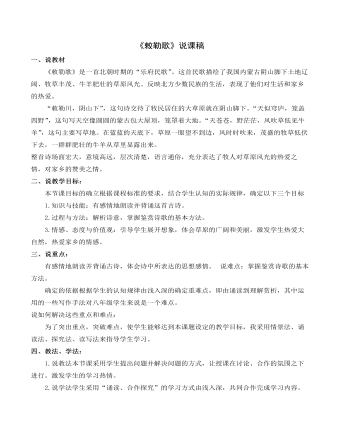
《敕勒歌》说课稿
动静结合。诗的前六句是静态的勾画;“风吹草低见牛羊”,这句是动态的描写。风吹草低,这一现啊,不仅现出了牛羊,还现出了草原的灵动。色彩的丰富,画面的灵动,使敕勒川变得更加美丽。
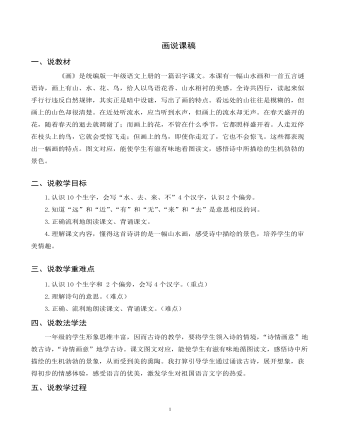
《画》说课稿
(坚持以读为本,让学生真正成为语文课堂的“读者”,通过自由读、分组读、指名读、教师引读等多形式的朗读,引导学生图文对照,感悟诗句的内容和表达的感情。另外,文中句子的节奏感很强,朗读时指导学生读出诗的节奏和韵味,在读中感悟、体会诗的读法,想象诗中描绘的美好画面,感受画的美,语言文字的美,激发学生对祖国语言文字的热爱之情。)

